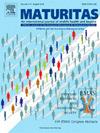State anxiety is associated with hormonal, cardiovascular, and sleep parameters in Finnish postmenopausal women
IF 3.6
2区 医学
Q2 GERIATRICS & GERONTOLOGY
引用次数: 0
Abstract
Objective
To investigate how a range of variables, both physiological (sleep architecture, serum follicle-stimulating hormone (S-FSH), anthropometric and blood pressure measures) and non-physiological (stressful life events, education), are associated with symptoms of distress, anxiety, and depression from premenopause to postmenopause and at postmenopause.
Methods
We recruited 64 women (ages 45–47). Data were derived from an in-house questionnaire, the Brief Symptom Inventory, State-Trait Anxiety Inventory, Beck Depression Inventory, a sleep questionnaire, physiological measurements, and polysomnography at baseline and at ten-year follow-up.
Results
During the follow-up, an increase in weight was associated with an increase in anxiety as recorded by the Brief Symptom Inventory (p = 0.012, R2 = 0.117). Cross-sectionally, at postmenopause, state anxiety was associated with an increase in blood pressure and S-FSH, delayed REM sleep, and the use of menopausal hormone therapy (pSTAI-S < 0.001, R2 = 0.343). Distress and depressive symptoms were associated with stressful life events and a lower level of education but also with an increase in diastolic blood pressure and use of hormone therapy (pBSI < 0.001, R2 = 0.328 and pBDI < 0.001, R2 = 0.312). Sleep disruptions were associated with psychological symptoms but vasomotor symptoms were not.
Conclusions
The change in psychological symptoms during the follow-up was modest. At postmenopause, distress and depressive symptoms were associated with a range of physiological and non-physiological parameters, but state anxiety only with physiological parameters. At postmenopause, psychological symptoms were more sensitive to sleep disruptions than were vasomotor symptoms.
芬兰绝经后妇女状态焦虑与激素、心血管和睡眠参数相关
目的研究一系列生理变量(睡眠结构、血清促卵泡激素(S-FSH)、人体测量和血压测量)和非生理变量(压力生活事件、教育)如何与绝经前、绝经后和绝经后的痛苦、焦虑和抑郁症状相关。方法招募64名女性,年龄45-47岁。数据来源于内部问卷、简要症状量表、状态-特质焦虑量表、贝克抑郁量表、睡眠问卷、生理测量以及基线和10年随访时的多导睡眠图。结果在随访期间,体重增加与焦虑增加相关(p = 0.012, R2 = 0.117)。在绝经后,状态焦虑与血压和S-FSH升高、快速眼动睡眠延迟以及绝经期激素治疗的使用有关(pSTAI-S <;0.001, r2 = 0.343)。苦恼和抑郁症状与紧张的生活事件和较低的教育水平有关,但也与舒张压升高和激素治疗的使用有关(pBSI <;0.001, R2 = 0.328, pBDI <;0.001, r2 = 0.312)。睡眠中断与心理症状有关,但与血管舒缩症状无关。结论随访期间心理症状变化不大。绝经后,苦恼和抑郁症状与一系列生理和非生理参数相关,但状态焦虑仅与生理参数相关。在绝经后,心理症状比血管舒缩症状对睡眠中断更敏感。
本文章由计算机程序翻译,如有差异,请以英文原文为准。
求助全文
约1分钟内获得全文
求助全文
来源期刊

Maturitas
医学-妇产科学
CiteScore
9.10
自引率
2.00%
发文量
142
审稿时长
40 days
期刊介绍:
Maturitas is an international multidisciplinary peer reviewed scientific journal of midlife health and beyond publishing original research, reviews, consensus statements and guidelines, and mini-reviews. The journal provides a forum for all aspects of postreproductive health in both genders ranging from basic science to health and social care.
Topic areas include:• Aging• Alternative and Complementary medicines• Arthritis and Bone Health• Cancer• Cardiovascular Health• Cognitive and Physical Functioning• Epidemiology, health and social care• Gynecology/ Reproductive Endocrinology• Nutrition/ Obesity Diabetes/ Metabolic Syndrome• Menopause, Ovarian Aging• Mental Health• Pharmacology• Sexuality• Quality of Life
 求助内容:
求助内容: 应助结果提醒方式:
应助结果提醒方式:


